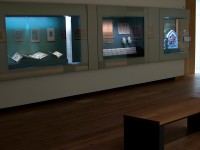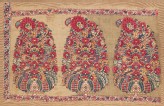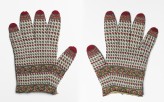Room 33 | Mughal India 1500-1900 gallery
Discover the paintings and decorative arts of the Mughal period - the most powerful and lasting of the Islamic dynasties in India.

In Mughal times, fine textiles and costume played a major part in courtly display. By 1650, a flowering plant motif had become a dominant theme. It originated in Jahangir's enthusiasm for the flora of Kashmir in spring, as well as in the Mughal artists' study of European herbals or plant books.
In increasingly stylised forms, the flower motif appeared everywhere in the arts: in the stone inlay decoration of the Taj Mahal, the borders of painting albums, or on a nobleman's waist-sash. It appeared also in the famous shawls of Kashmir, later evolving into a vase of flowers motif, which then merged with a Persian abstract leaf pattern (buta) with its tip bent over.
Famous for their softness, lightness and warmth, Kashmir shawls were woven from the fine fleece of a Himalayan mountain goat. By 1800 they had become a high fashion item in Europe. They were widely imitated by local manufacturers, including those of Paisley in Scotland.
Notice
Objects may have since been removed or replaced from a gallery. Click into an individual object record to confirm whether or not an object is currently on display. Our object location data is usually updated on a monthly basis, so contact the Jameel Study Centre if you are planning to visit the museum to see a particular Eastern Art object.
© 2013 University of Oxford - Ashmolean Museum


